Brotherhood of the Wolf (2001)
Written by: Christophe Gans, Stéphane Cabel
Starring: Mark Dacascos, Monica Bellucci, Samuel Le Bihan, Vincent Cassel
AKA LE PACTE DES LOUPS
France
AVAILABLE ON BLU-RAY AND DVD
RUNNING TIME: 150 min [director’s cut], 143 mins, 137 mins
REVIEWED BY: Dr Lenera, Official HCF Critic
In 1764 France, a mysterious beast terrorises the province of Gévaudan. Gregoire de Fronsac, a knight and the royal naturalist of King Louis XV of France, and his Iroquois companion Mani, arrive to capture the beast. Gregoire falls for and tries to romance Marianne de Morangias, the daughter of a local count, while satisfying his baser needs with Sylvia, an Italian prostitute. While investigating a victim, Fronsac finds a fang made of steel, and a traumatised child witness swears that he saw the beast with what looked like a human master. While back in Paris, Fronsac discovers the ghastly truth about the creature.…
One of the many fine things about John Wick: Parabellum was seeing Mark Dacascos, who was once on the verge of becoming a true martial arts star around the turn of the century, being back on the big screen again. That made me check out Brotherhood Of The Wolf, a film I remembered as being his finest, again, though I discovered something I [who prides himself on being knowledgeable about different versions of movies and will not see a cut film if he can help it] didn’t know – the UK version was not actually the full version – which meant of course that I had to buy the latter on Blu-ray to watch and review. But it was money well worth spent. While Dascascos is not actually in it as much as I remembered, this is a cracking film that might initially seem to be just a monster/horror movie [you could almost call it a werewolf film without a werewolf] but which also proceeds to go from romance to martial arts action to political intrigue to several other things, packing in as bewildering assortment of plot elements as possible along the way. What’s so impressive is how well it all works, the switches feeling organic rather than random, and the story actually being really well worked out. It is rather long, and I guess if you wanted to you could cut portions out to focus on the main narrative, but I think that much of its unique quality would be lost and it certainly wouldn’t be a better film for it. And it looks absolutely stunning throughout. I don’t know why it had been so long since I’d last seen it, but as I watched it again I remembered how thrilling an experience it was at the cinema for me. I mean – enjoy a great many French films old and new, they certainly have their particular qualities – but how many French films do you come out of saying, “that ROCKED”!?
There actually was a Beast of Gévaudan, a wolf-like creature that prowled the Auvergne and South Dordogne regions of France during the years 1764 to 1767, killing about 100 people. Officially, as in the film, the Beast was shot and killed by the ‘King’s Hunter’ in September of 1765. However, further attacks plagued the region until June of 1767 when a local hunter shot and killed a wolf which, upon examination, was found to have human flesh in its stomach, and is now believed by many to have been the true Beast of Gevaudan. Unsurprisingly, that latter part isn’t in the film, but it is a movie in which, except the Native American Mani, all of the primary characters really existed, and lived during the reign of King Louis XV. Shot at the Château de Roquetaillade in Mazères, Gironde, and Esparros, Hautes-Pyrénées, it was an elaborate production, especially for France. To prepare for his role, Dacascos learned how to ride a horse, study Mohawk Indian culture, and became fluent in French. It was a big hit in France and was the second-highest-grossing French-language movie in the United States since 1980. The 143 minute French cut was the one shown in most countries. It removed seven minutes from the full version, mainly scenes involving our hero’s two loves from the middle of the film. The UK saw a different 139 minute cut which removed all the scenes involving the Royal Hunter Beauterne but restored most of the cut footage from the ‘Director’s Cut’. The Director’s Cut that was later released in some countries [but so far not the UK – for gods sake why?] really is the one to see in my opinion [the Korean Blu-ray is cheap and region free], but then even the deleted scenes for this film are good, including a longer opening fight and a bordello scene revealing that Sylvia is in fact the only person who knows the whole truth to both sides of the story regarding the Beast.
The dexterity of the camerawork in this film is immediately shown in the very first scene where we descend a wall of a large house and, via CGI, go through a window to join the Marquis d’Apcher writing his memoirs in his castle. It’s the French revolution and the Marquis’s time has come, but he seems to be awaiting his fate with dignity. He narrates bits of the main bulk of the film and his character as a younger one plays a major part, though obviously we see many events that he can’t have witnessed. The camera soars over the countryside to witness a young woman pushed by something onto some rocks, then fall off a cliff edge to be swung from side to side until dead. It’s the first of several monster kills that show very little but which have real impact, though they’re probably the only bits where director Christopher Gans employs some subtlety. Gregoire and Mani show up in the area and encounter an old man and a young woman being beaten for supposed witchcraft. Mani soon sorts things out, aided by some wire work that enables Mani to do things like run up an opponent. The editing and bits of slow motion detract a little from the effect of the fighting [choreography by Hong Kong veteran Philip Kwok], though it’s nowhere near as bad as the ‘shakycam’/hyper fast cutting that became often employed soon after where you could see sod all. A short while later, Mani takes on a load of soldiers including two women, an event caused by the same woman, a woman who remains an enigma even when we learn much more about her towards the end. This brawl really is gratuitous, but those out for a non-stop fight fest will then be disappointed as that’s all we get in terms of fight action until the final third, but there’s really so much else to enjoy here.
The place is in a bad way, with the Beast killing people and Captain Duhamel not knowing what do about it, while his men cause havoc. But Gregoire would rather pursue Marianne while also sleeping with prostitute Sylvia. Sylvia is one of Monica Bellucci’s simplistic film roles, though I’m not sure that she’s ever looked more delectable on screen, and quite frankly Gregoire has got it made, able to tell Sylvia how much he loves Marianne [why? You’re with Monica Bellucci?!!] yet still use her for sex. Samuel Le Bihan is able to always make his character sympathetic, while Bellucci is given one good moment where it looks like her character might be crying because she’s fallen for Gregoire. The theme of fakery that’s a major one in the film is introduced when Gregiore shows off a supposed furry fish at dinner, only to admit it’s a fake when Marianne’s father Jean-François isn’t impressed – and by the way you immediately know that Jean-François is a bad guy because he’s played by Vincent Cassel with that sneering relish that makes his villains so fun to watch. Duhamel organises a huge hunt that results in the killing of loads of wolves, but Fronsac prefers to chill and draw pictures. The King sends Royal Hunter Beauterne to take over from Duhamel, and I couldn’t believe that the version I used to watch was missing the gruesome makeover Beauterne gets Fronsac to do on a wolf so he can present it to the Palace as the Beast. Charting the Beast’s attacks on a map, Fronsac notices that all of the lines connecting them intersect at one point, and he and Mani go looking, leading to the big action you’ve been waiting for, though even in this section we take a sidestep into political mechanisms, murder and incest. In fact it’s here where things really do threaten to go nuts what with the crazy plot turns Gans and his co-screenwriter Stéphane Cabel bring to the table. But at least this means that there’s some unpredictability first time around – and yet most things do eventually tie in. This never stops being a bloody good story.
When you eventually see it properly, the Beast is a Jim Henson puppet creation, and it looks pretty good except for when it moves fast, where it tends to resemble stop motion – though I personally like the stilted weirdness that stop motion provides, it’s rather freaky, and no less convincing then the way many CG creature look when they move today, Despite all the sword swinging and kung fu kicks, the final confrontation with the Beast emphasises pity, compassion, and anger at the way humans treat animals, the screenplay unashamedly also attacking the rich and the Catholic Church. There’s also an element of xenophobia in the arrogant, even racist way folk look at Mani who for much of the time just wants to help and often heal. But don’t be fooled that this film is heavy, I mean you’re not asked to take too seriously a film where the camera pans up Bellucci’s body and goes between her tits as we dissolve to the snowy outdoors with the breasts replaced by hills. Cinematographer Dan Laustsen’s camera tracks all over the place and rarely keeps still, though fortunately this was back when a camera shaking was usually considered bad filmmaking. Especially impressive is a track around the walls of a room which have mirrors showing Fronsac and Sylvia having sex. A good deal of the film is lit by candle or fire light, filling the screen with warm oranges and flesh tones, while elsewhere Laustsen emphasises both the beauty and the eeriness of outdoor locations [there’s loads of fog], while Joe LoDuca’s music score is often just plain odd. There’s some conventional dramatic scoring, especially at the end which adds much emotion [remember the framing device], but elsewhere LoDuca uses a variety of ethnic sounds with seemingly little rhyme or reason. But then this is a film where one of the characters is a Native American who knows Asian martial arts.
Then again, everyone seems to know how to fight with skill in the final act, and I do think that it would have been better if Fronsac’s fighting expertise had been gradually built up to rather than suddenly being sprung upon us. Le Bihan clearly can’t fight much, but the editing helps a bit, and in terms of acting he’s fine in his role, displaying plenty of appropriate intensity towards the end. Dacascos barely says a word but really does have a strange kind of screen presence, though if the film were released today his role would no doubt be criticised by the PC morons as being stereotypical and culturally insensitive, especially as Dacascos is most definitely not a Native American. But in general Brotherhood Of The Wolf is a blast. When it comes down to it it’s basically very silly, but it’s also supremely well crafted and a highly successful juggling act – and as I type, I wonder if it really is all that silly, as it occurred to me how both of the film’s principal villains seem to be basically afraid of progress as they desperately try to shield their world from the future.
Rating: 










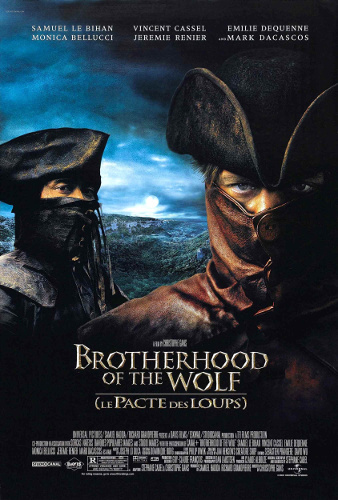
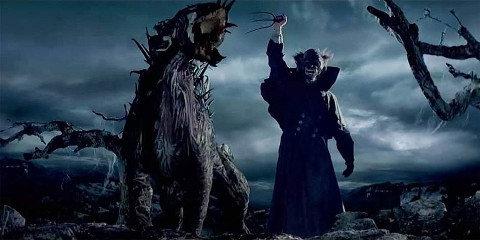
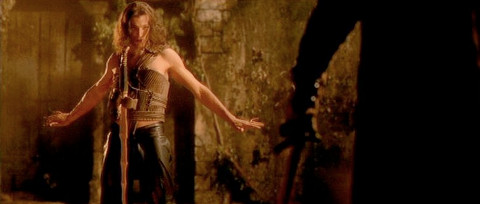

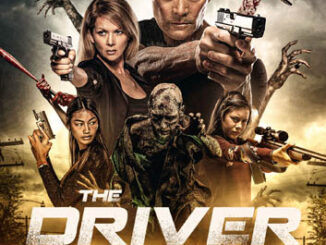
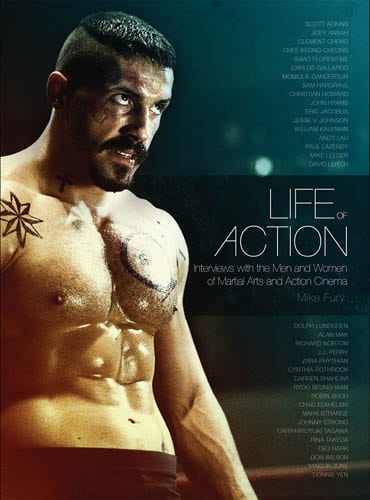
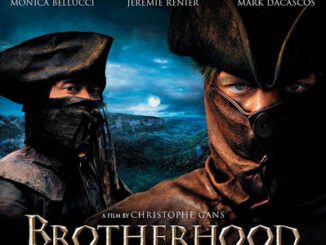
Yeah, great film this
Couldn’t really put my finger on why I liked it so much
Not pure horror, action or any other easy category, but then it was different and that was fine with me. Might have to follow recommendation about uncut blu-ray.